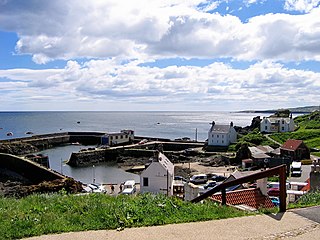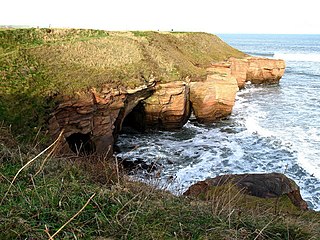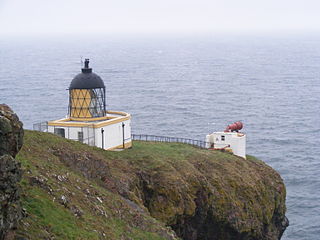
The Scottish Borders is one of 32 council areas of Scotland. It borders the City of Edinburgh, Dumfries and Galloway, East Lothian, Midlothian, South Lanarkshire, West Lothian and, to the south-west, south and east, the English counties of Cumbria and Northumberland. The administrative centre of the area is Newtown St Boswells.

Bunyavirales is an order of negative-sense single-stranded RNA viruses. It is the only order in the class Ellioviricetes. It was formerly known as Bunyaviridae family of viruses. The name Bunyavirales derives from Bunyamwera, where the original type species Bunyamwera orthobunyavirus was first discovered. Ellioviricetes is named in honor of late virologist Richard M. Elliott for his early work on bunyaviruses.

St Abbs is a small fishing village on the southeastern coast of Scotland, United Kingdom within the Coldingham parish of Berwickshire.

St Abb's Head is a rocky promontory by the village of St Abbs in Berwickshire, Scotland, and a national nature reserve administered by the National Trust for Scotland. St Abb's Head Lighthouse was designed and built by the brothers David Stevenson and Thomas Stevenson and began service on 24 February 1862.
Æbbe was an Anglian abbess and noblewoman. She was the daughter of Æthelfrith, king of Bernicia from c. 593 to 616. She founded monasteries at Ebchester and St Abb's Head near Coldingham in Scotland.
Phlebovirus is one of four genera of the family Phenuiviridae in the order Bunyavirales. The genus currently comprises 10 species. It derives its name from Phlebotominae, the vectors of member species Sandfly fever Naples phlebovirus, which is said to be ultimately from the Greek phlebos, meaning "vein". The proper word for "vein" in ancient Greek is however phleps (φλέψ).

Mire Loch is a man made freshwater loch situated on St Abb's Head in the Scottish Borders, just over a kilometre NW of the village of St. Abbs at grid reference NT912687. The loch lies on land owned by the National Trust for Scotland (NTS) and is approximately 600 metres long by 50 metres at its widest point.

Severe fever with thrombocytopenia syndrome (SFTS) is an emerging infectious disease recently discovered in northeast and central China. SFTS has fatality rates ranging from 12% to as high as 30% in some areas. The major clinical symptoms of SFTS are fever, vomiting, diarrhea, multiple organ failure, thrombocytopenia, leucopenia, and elevated liver enzyme levels.
Huaiyangshan banyangvirus, formerly SFTS virus, is a tick-borne Banyangvirus in the order Bunyavirales. It appears to be more closely related to the Uukuniemi virus serogroup than to the Sandfly fever group. It is a member of the Bhanja virus serocomplex.
Heartland banyangvirus, sometimes called Heartland virus (HRTV), is a tick-borne phlebovirus of the Bhanja virus serocomplex discovered in 2009. The lone star tick transmits the virus to people when feeding on blood. As of 2017, only five Midwestern United States have reported 20 human infections, namely Arkansas, Indiana, Missouri, Oklahoma, and Tennessee; symptoms resemble those of two other tick-borne infections ehrlichiosis and anaplasmosis. The reservoir host is unknown, but deer, raccoon, coyotes, and moose in 13 different states have antibody titers against the virus.
Sandfly fever Naples phlebovirus (SFNV) is an antigenic species of genus Phlebovirus within the family Phenuiviridae of the order Bunyavirales. It is an enveloped RNA virus with a tripartite genome e Uukuniemi (UUK) serogroup. The Sandfly group's natural reservoir are sandflies, while the natural reservoir for Uukuniemi is ticks. The SFNV serogroup consists of two main serocomplexes associated with disease in humans, the Naples and Sicilian serocomplexes. Sandfly fever induces myalgia, fever, and elevated liver enzymes in humans. It is difficult to diagnose outside endemic areas.
Adria virus (ADRV), named after the Adriatic Sea, is a phlebovirus transmitted by sandflies that can cause a febrile illness in people. It has been found in sandfly populations in Albania and northern Greece.
Alenquer virus (ALEV) is a serotype of Candiru virus in the genus Phlebovirus. This New World phlebovirus was one of eight new arboviruses isolated in the early 1980s from sites along roads built into the Amazon rainforest in Brazil for settlers. Sporadic cases of febrile illness have occurred in humans who live in jungle areas in Brazil and Panama. Alenquer virus was included in the Control of Communicable Diseases Manual from the 14th (1985) through the 17th (2000) editions.
Candiru phlebovirus (CDUV) is a species in the genus Phlebovirus.

The Berwickshire Coastal Path is a walking route some 48 kilometres (30 mi) long. It follows the eastern coastline of Scotland from Cockburnspath in the Scottish Borders to Berwick upon Tweed, just over the border in England. At Cockburnspath the path links with the Southern Upland Way and the John Muir Way.
Batai virus (BATV) is a RNA virus belonging to order Bunyavirales, genus Orthobunyavirus.
Amalgaviridae is a family of double-stranded RNA viruses that has two genera: Amalgavirus and Zybavirus. Members of both the family and of the genus Amalgavirus are referred to as amalgaviruses. There are currently ten recognized species of the family. The family is called amalga, from amalgam, due to the viruses possessing characteristics of both partitiviruses and totiviruses, indicating a likely genetic relation to those two families. Members of this family infect plants and are transmitted vertically via seeds. Their genomes are monopartite, about 3.5 kilobases in length, and contain two partially overlapping open reading frames, encoding the RNA-dependent RNA polymerase (RdRp) and a putative capsid protein.
The Punta Toro virus is a member of the genus Phlebovirus of the order Bunyavirales. It was initially isolated from patients in Colombia and two key patients in Panama. Two individual serotypes of PTV were isolated from these patients, PTV-Adames (A) and PTV-Balliet (B), with PTV-A appearing to be more virulent. PTV is considered to be relatively contained to the Americas with no cases being reported outside of this region. Along with a few other human pathogenic Phleboviruses, PTV is considered to be a significant virus in terms of public health as little information is known about its clinical effects and with further research underway, PTV could have unforeseen impacts on health and virology.
Phenuiviridae is a virus family belonging to the order Bunyavirales established by ICTV in 2016. Ruminants, camels, humans, and mosquitoes are the known hosts of members of this negative-sense single-stranded RNA virus family. Of the four genera, Phlebovirus is the only genus that includes viruses that cause disease in humans.

St Abb's Head Lighthouse stands on the cliffs at the rocky promontory of St Abb's Head, near the village of St Abbs in Berwickshire.







